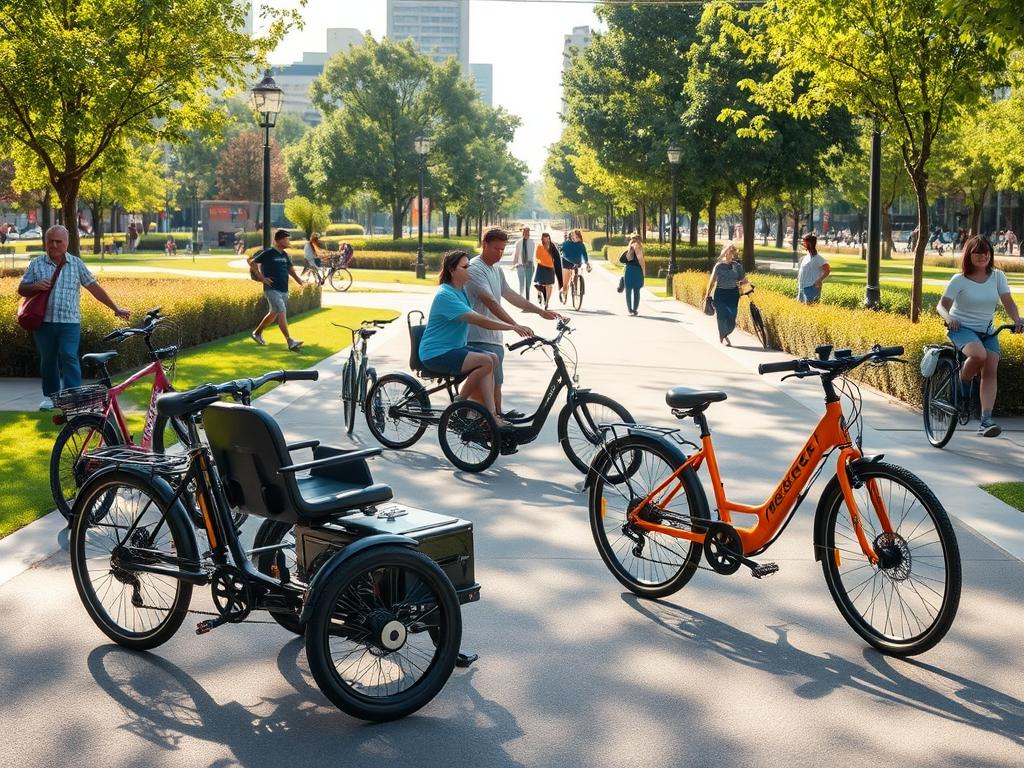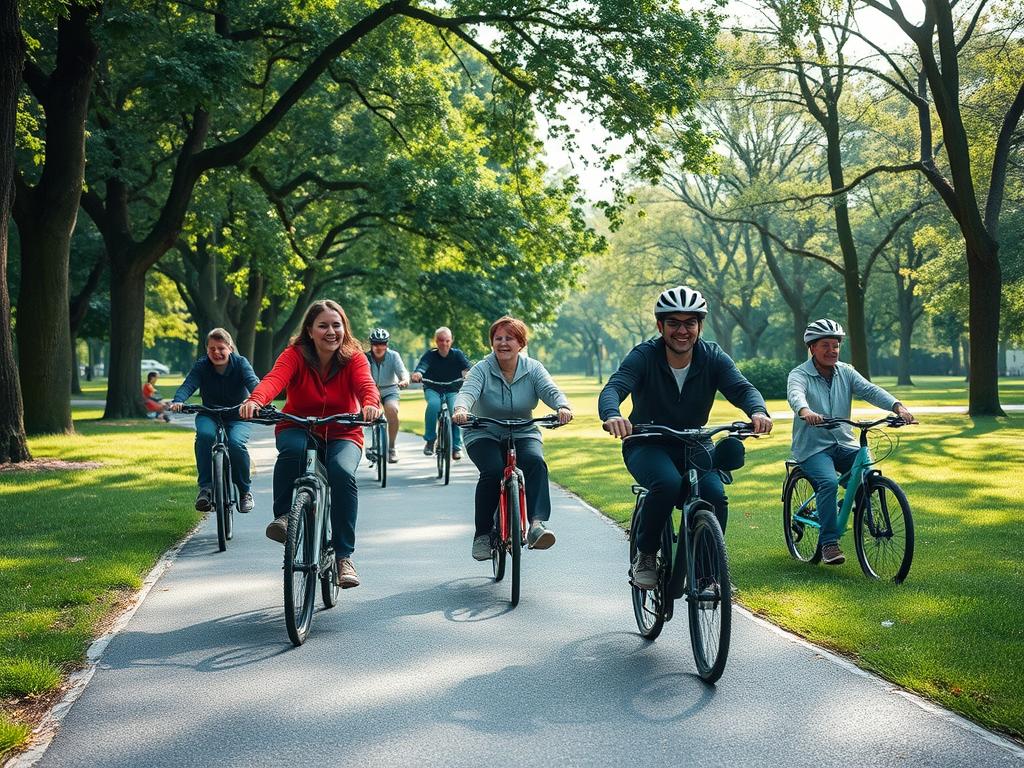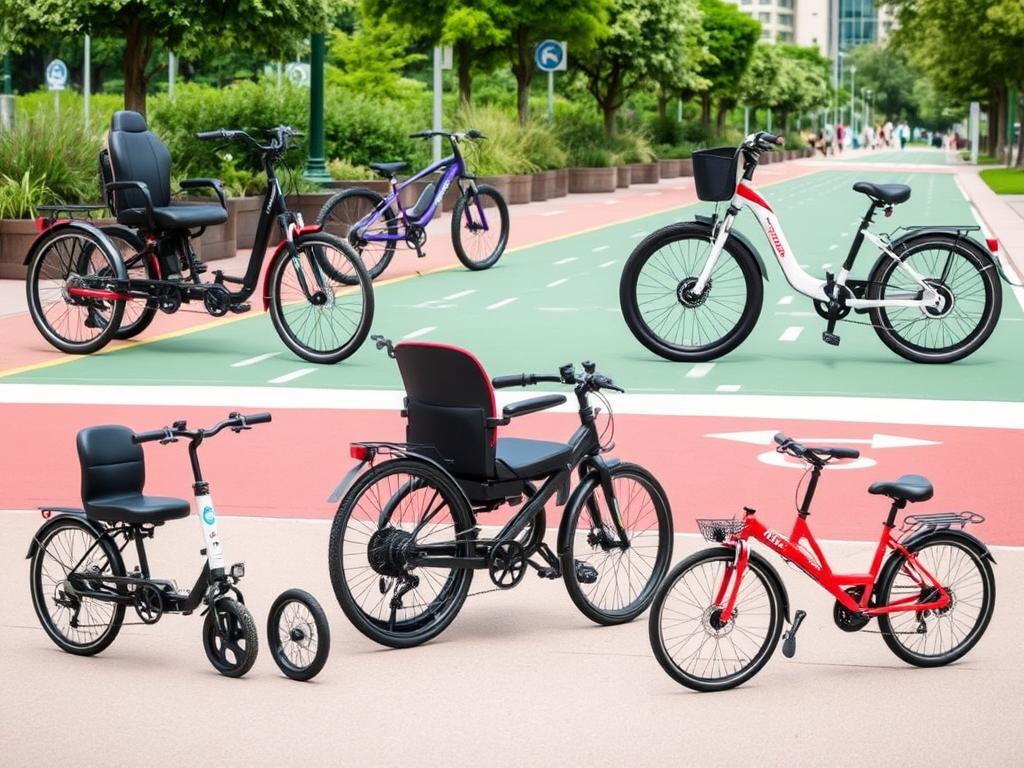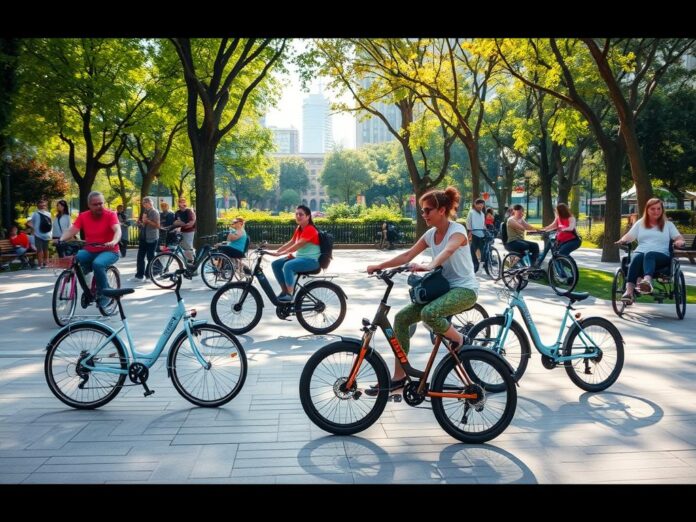Electric bikes have changed the game for people with disabilities, giving them more freedom and independence. These innovative e-Bikes offer motorized help, letting users stay active and fit. They don’t replace the effort of riding a bike, making them safe and easy to use in traffic.
In many places, e-bikes can only go up to 25 km/h (15.5 mph), making them a safe choice. There are many types of Disabled Friendly e-Bikes out there. They offer features like stability, comfort, and customization, meeting the needs of all riders.
Key Takeaways
- Disabled Friendly e-Bikes offer motorized assistance, enabling users to stay active and overcome physical limitations.
- E-bikes provide a safe and seamless integration into regular traffic, with a legal top speed of 25 km/h (15.5 mph) in many countries.
- Disabled Friendly e-Bikes are available in various categories, catering to the diverse needs and preferences of riders with different abilities.
- Accessibility features and customization options are crucial for enhancing the mobility and independence of disabled riders.
- The future of Disabled Friendly e-Bikes shows promise, with advancements in adaptive technology expected to enhance more lives in the coming years.
Understanding Disabled Friendly e-Bikes
Adaptive Cycling Solutions are changing how people with disabilities move around. Disabled friendly e-bikes, or electric bicycles, meet the needs of riders with different challenges. These bikes mix accessibility, comfort, and empowerment, changing daily life for people with disabilities.
What are Disabled Friendly e-Bikes?
Disabled friendly e-bikes are electric bikes made for riders with various abilities. They have step-through frames for easy getting on and off. They also have adjustable parts like handlebars and seats for a custom fit.
Key Features to Look For
- Low step-through frames for easy access
- Stable and balanced designs for enhanced safety
- Adjustable handlebars, seats, and pedals for customized fit
- Powerful electric motors to assist with pedaling
- Customizable pedal-assist levels to match individual needs
These solutions are for many users, from those with limited mobility to those who want to stay active. Disabled friendly e-bikes combine electric power with special features. This makes them a versatile and empowering way to get around.

“Study cited by Texas researchers showed individuals with cognitive and physical impairments expressed feeling a sense of freedom while riding e-bikes.”
As more people look for accessible transport, disabled friendly e-bikes lead the way. They help people with disabilities explore, stay independent, and live active lives.
| Feature | Benefit |
|---|---|
| Low step-through frames | Easier mounting and dismounting for riders with limited mobility |
| Adjustable handlebars and seats | Personalized comfort and control for individuals with diverse needs |
| Powerful electric motors | Provide pedal-assist to reduce physical strain and effort |
| Customizable pedal-assist levels | Allow riders to tailor the level of support to their abilities |
Benefits of e-Bikes for Disabled Riders
E-bikes have changed the game for disabled riders. They offer a Barrier-Free Biking Experience. These Empowering Cycling Technology solutions bring many benefits. They improve independence and quality of life.
Improved Mobility and Independence
E-bikes let disabled riders go further without getting tired. They make hills easier and keep a steady pace. This means more freedom to explore on their own.
Health Benefits of Riding an e-Bike
Using an e-bike boosts heart health, muscle strength, and mental well-being. The help with pedaling eases joint pain. This makes cycling easier for those with physical challenges.
Economic Advantages of Using e-Bikes
E-bikes are cheaper than many mobility aids. They can cut down on car trips, saving money and the environment. For many, e-bikes are a smart, affordable choice for daily travel.
| Benefit | Description |
|---|---|
| Improved Mobility | E-bikes allow disabled riders to travel longer distances with less fatigue, tackle hills more easily, and maintain a consistent pace. |
| Health Benefits | Riding an e-bike can lead to improved cardiovascular fitness, muscle strength, and overall mental well-being. |
| Economic Advantages | E-bikes offer a cost-effective alternative to traditional mobility aids and can replace car trips, reducing transportation costs and the environmental impact. |

“Adaptive bicycles foster inclusion and independence among riders with disabilities.”
Types of Disabled Friendly e-Bikes
Exploring the world of [Inclusive Outdoor Adventures] and [Disability-Friendly Recreational Vehicles] is easier with the many e-bike options available. These bikes are designed for riders with different needs and abilities. They offer stability, comfort, and empower disabled individuals to enjoy the outdoors.
Tricycles for Stability and Safety
Electric tricycles provide a stable and secure ride, perfect for those with balance issues or limited mobility. Their three wheels ensure a sturdy base, making them great for uneven terrain. [https://ebikesus.com/e-bike-for-seniors/]
Recumbent e-Bikes for Comfort
Recumbent e-bikes have a laid-back design that reduces back and joint strain. They are popular for their comfort and ergonomic design. The reclined seating also improves stability and visibility.
Adaptive e-Bikes for Custom Needs
Adaptive e-bikes can be customized to meet specific needs. They offer features like hand cycles, tandem configurations, or wheelchair platforms. This customization makes cycling accessible and enjoyable for disabled riders.
| e-Bike Model | Key Features | Price Range |
|---|---|---|
| Viribus Trigo Plus Adult Electric Tricycle | – 250W brushless motor – Pedal assistance up to 15.5 mph – 36V 10Ah lithium-ion battery |
$2,000 – $3,000 |
| Cube Trike Family Hybrid 750 | – Designed for families – Stable and efficient electric cargo bike – Can transport children, groceries, or heavy loads |
$3,000 – $4,500 |
| Ferla Cargo Bike – Royce Edition | – Custom model for disabled clients – Luxury push-snap doors – Front bucket compartment |
$4,999.99 – $6,499.00 |

“Adaptive bikes offer individuals with disabilities the opportunity to engage in cycling activities through specialized designs that cater to various physical needs.”
Features that Enhance Accessibility
When it comes to disabled-friendly electric bicycles, or Accessible Electric Bicycles, the key lies in thoughtful design. These bikes focus on ease of use and comfort. They have low-step frames and adjustable controls, making them a game-changer for those with disabilities.
Low-Step Frames for Easy Mounting
Regular bike frames can be hard for those with limited mobility. Disabled-friendly e-bikes have low-step or step-through frames. This makes it easy to get on and off, ensuring a smooth ride.
Handlebars and Controls for All Abilities
Customizable handlebars and controls are key for different abilities. These e-bikes offer adjustable options. This includes one-handed operation and alternative controls, letting riders tailor their ride.
Adjustable Seats for Personalized Comfort
Comfort is crucial for disabled riders, and adjustable seats are vital. E-bikes with this feature let users find the perfect seat. This reduces strain and improves the ride.
Some e-bikes also have wider tires for stability, cargo capacity, and built-in lights for safety. These features make Accessible Electric Bicycles a big step forward in transportation for everyone.
“E-bikes have the potential to make biking more accessible for older adults, people with disabilities, and individuals who struggle with the resistance of conventional bikes.”
Choosing the Right e-Bike for Your Needs
When picking the right Adaptive Cycling Solutions, consider a few key things. First, think about your personal needs. This includes your disability, riding goals, and physical abilities.
Next, think about where and how you’ll use your e-bike. Will it be for city commuting or off-road adventures? This will help you choose the right motor power, battery, and frame.
Comparing Brands and Models
There are many Disability-Inclusive Transportation options out there. Look at motor power, battery range, frame design, and accessories. These features can make a big difference in your ride.
Try out different e-bikes if you can. This lets you see how they feel and work. It’s important to find one that fits your needs and improves your life.
Talking to healthcare professionals or mobility experts can also help. They can offer advice and insights to find the best e-bike for you.
“With the right Adaptive Cycling Solutions, I’ve experienced a newfound sense of independence and freedom in my daily life. The e-bike has been a game-changer for my mobility.”
Choosing the right e-bike is about finding the right balance. Consider your needs, how you’ll use it, and try out different models. This way, you can find the perfect Disability-Inclusive Transportation solution for your life.
Understanding the Cost of Disabled Friendly e-Bikes
Living with a disability can be tough, but disabled-friendly e-bikes are changing the game. They offer a Barrier-Free Biking Experience that’s empowering. Even though they cost more upfront, the benefits last a long time.
Price Range Breakdown
Prices for these e-bikes vary from $1,500 to $5,000. Some models, especially those with special features, can cost even more. The price depends on the motor, battery, frame, and customizations needed.
Factors Affecting e-Bike Costs
- Motor quality: Better motors cost more.
- Battery capacity: Bigger batteries raise the price.
- Frame materials: High-quality frames like carbon fiber or aluminum are pricier.
- Custom adaptations: Special features and customizations add to the cost.
Financing and Assistance Programs
Some places offer financing or help to make these e-bikes more affordable. Organizations like Wheels for Wellbeing in the UK help people get adaptive cycles. It’s important to think about the long-term benefits and health gains these bikes offer.
“The design of Ferla Family Cargo Bikes prioritizes safety, style, and usability, including features like a Fully Enclosed Sun & Rain Canopy and three-point safety harness belts in the front load bucket.”
Safety Considerations When Riding
When you’re out on your Inclusive Outdoor Adventures, safety is key. Whether you’re on a disability-friendly e-bike or just around town, knowing the right safety gear and riding tips is crucial.
Gear Up for a Safe Ride
Get a helmet that fits well to protect your head in an emergency. Look for helmets with MIPS technology for extra protection. Wear reflective clothes and lights to be seen, especially at night.
Navigate the Roads Safely
Always follow local bike laws and use bike lanes when you can. Stay alert and ride smart. Know how to use your e-bike’s controls for a safe ride.
Tips for New Riders
- Start in safe, low-traffic areas to build your confidence and skills.
- Practice proper mounting and dismounting techniques to ensure stability.
- Experiment with the different assistance modes to find the right level of support for your needs.
- Pay attention to how your e-bike handles, as it may be different from a traditional bicycle.
By focusing on safety and following good practices, you can enjoy the freedom of e-bikes. A bit of preparation makes your adventures safe and memorable.
Maintenance Tips for Your e-Bike
Keeping your Accessible Electric Bicycles or Mobility-Enhancing e-Bikes in good shape is key. It ensures they last long, are safe, and work well. By following simple maintenance steps, you can keep your e-bike running smoothly. Here are the essential tips for your e-bike’s upkeep.
Regular Checks and Repairs
Do regular checks on your e-bike, especially the tires, brakes, and chain. Make sure the tires are at the right pressure and look for any damage. Also, check that the brakes work right and the chain is well-lubricated and tight.
Don’t forget to clean and lubricate your bike often. This helps prevent rust and keeps everything moving smoothly.
Best Practices for Battery Care
Looking after your Mobility-Enhancing e-Bikes‘ battery is crucial. Follow the maker’s advice on charging and storage. Keep the battery away from very hot or cold places. Also, keep it partially charged if you won’t be using it for a while.
By following these tips, your e-bike’s battery will stay in great shape.
Finding a Good Mechanic
For big repairs or yearly check-ups, see a trusted e-bike mechanic. Choose someone who knows Accessible Electric Bicycles and adaptive cycling gear. Some makers even have special service programs or training for bike shops.
Regular maintenance and expert help will keep your e-bike in top shape. This way, you can enjoy e-bike ownership for many years.
Future of Disabled Friendly e-Bikes
The future of e-bikes for people with disabilities is bright. New technologies are making these bikes more accessible and powerful. These changes are creating a more inclusive world for everyone.
Emerging Technologies in e-Bikes
New e-bike tech is changing the game for disabled riders. Features like smart systems that learn your ride, better batteries for longer trips, and apps for tracking are coming. These updates make riding better and meet the needs of disabled cyclists.
Community and Support for Disabled Riders
A growing number of disabled cyclists are making a difference. They’re pushing for more Adaptive Cycling Solutions and better ways to get around. Groups like Cycling UK and local clubs offer rides, support, and a voice for change. Together, they’re making cycling more accessible and empowering for everyone.
FAQ
Q: What are disabled friendly e-bikes?
Q: What are the key features to look for in disabled friendly e-bikes?
Q: What are the benefits of using e-bikes for disabled riders?
Q: What types of e-bikes are available for disabled riders?
Q: What accessibility features are important in disabled friendly e-bikes?
Q: How do I select the right e-bike for my needs?
Q: How much do disabled friendly e-bikes cost?
FAQ
Q: What are disabled friendly e-bikes?
A: Disabled friendly e-bikes are electric bikes made for riders with mobility issues. They have step-through frames for easy getting on and off. They also have adjustable parts for comfort and electric motors to help with pedaling.
Q: What are the key features to look for in disabled friendly e-bikes?
A: Look for low step-through frames and stable designs. Adjustable handlebars and seats are key. Also, customizable pedal assist levels are important. These bikes are great for commuting, fun rides, or as mobility aids.
Q: What are the benefits of using e-bikes for disabled riders?
A: E-bikes boost mobility and independence. They let users go farther without getting tired, tackle hills easily, and keep a steady pace. They also improve health, like heart fitness and muscle strength, and save money by cutting down on car trips.
Q: What types of e-bikes are available for disabled riders?
A: There are many e-bikes for different needs. Electric tricycles offer stability, recumbent e-bikes are comfy, and adaptive e-bikes can be customized. They can have hand cycles, tandem setups, or wheelchair platforms.
Q: What accessibility features are important in disabled friendly e-bikes?
A: Important features include low-step frames for easy on and off. Adjustable handlebars and seats are also key. Wider tires, cargo space, and lights can make riding better.
Q: How do I select the right e-bike for my needs?
A: Choose based on your disability, riding goals, and fitness level. Think about where you’ll ride and compare different bikes. Test rides are helpful. Always talk to health experts or mobility specialists to find the right bike.
Q: How much do disabled friendly e-bikes cost?
A: Prices vary, from
FAQ
Q: What are disabled friendly e-bikes?
A: Disabled friendly e-bikes are electric bikes made for riders with mobility issues. They have step-through frames for easy getting on and off. They also have adjustable parts for comfort and electric motors to help with pedaling.
Q: What are the key features to look for in disabled friendly e-bikes?
A: Look for low step-through frames and stable designs. Adjustable handlebars and seats are key. Also, customizable pedal assist levels are important. These bikes are great for commuting, fun rides, or as mobility aids.
Q: What are the benefits of using e-bikes for disabled riders?
A: E-bikes boost mobility and independence. They let users go farther without getting tired, tackle hills easily, and keep a steady pace. They also improve health, like heart fitness and muscle strength, and save money by cutting down on car trips.
Q: What types of e-bikes are available for disabled riders?
A: There are many e-bikes for different needs. Electric tricycles offer stability, recumbent e-bikes are comfy, and adaptive e-bikes can be customized. They can have hand cycles, tandem setups, or wheelchair platforms.
Q: What accessibility features are important in disabled friendly e-bikes?
A: Important features include low-step frames for easy on and off. Adjustable handlebars and seats are also key. Wider tires, cargo space, and lights can make riding better.
Q: How do I select the right e-bike for my needs?
A: Choose based on your disability, riding goals, and fitness level. Think about where you’ll ride and compare different bikes. Test rides are helpful. Always talk to health experts or mobility specialists to find the right bike.
Q: How much do disabled friendly e-bikes cost?
A: Prices vary, from $1,500 to $5,000 or more. Costs depend on the motor, battery, frame, and custom features. Some places offer help to make these bikes more affordable.
Q: What safety considerations are important when riding disabled friendly e-bikes?
A: Safety first! Wear a helmet, bright clothes, and lights. You might need extra gear like mirrors or horns. Always follow bike laws, use bike lanes, and start in safe areas.
Q: How do I properly maintain my disabled friendly e-bike?
A: Keep your e-bike in top shape. Check tires, brakes, and chain often. Clean and lube it regularly. Use a mechanic who knows e-bikes for special care.
Q: What is the future of disabled friendly e-bikes?
A: The future is bright! New tech will make e-bikes better and more accessible. Expect smarter systems, better batteries, and phone apps for tracking. The growing community of disabled cyclists will help make cycling more inclusive.
,500 to ,000 or more. Costs depend on the motor, battery, frame, and custom features. Some places offer help to make these bikes more affordable.
Q: What safety considerations are important when riding disabled friendly e-bikes?
A: Safety first! Wear a helmet, bright clothes, and lights. You might need extra gear like mirrors or horns. Always follow bike laws, use bike lanes, and start in safe areas.
Q: How do I properly maintain my disabled friendly e-bike?
A: Keep your e-bike in top shape. Check tires, brakes, and chain often. Clean and lube it regularly. Use a mechanic who knows e-bikes for special care.
Q: What is the future of disabled friendly e-bikes?
A: The future is bright! New tech will make e-bikes better and more accessible. Expect smarter systems, better batteries, and phone apps for tracking. The growing community of disabled cyclists will help make cycling more inclusive.






